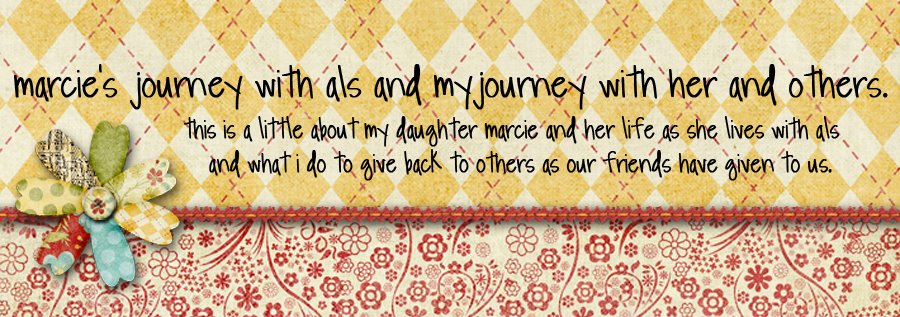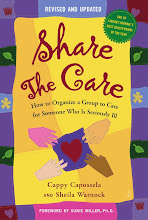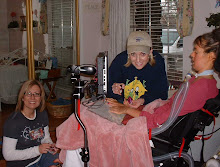 This story was written in March of 1998 for a book called Journeys With ALS written by PALS (People with ALS) and CALS (caregivers to people living with ALS) living with ALS - the book was put together by David Feigenbaum and his family.
This story was written in March of 1998 for a book called Journeys With ALS written by PALS (People with ALS) and CALS (caregivers to people living with ALS) living with ALS - the book was put together by David Feigenbaum and his family.This is Marcie's Story - written by me - her Mom -
Arlington, Texas - In the spring of 1991, Marcie tried out for the Dallas Cowboy Cheerleaders at Texas Stadium. After several weeks of tryouts she made it through three cuts. For the fourth and final segment, she had to makeup her own dance and costume. Unfortunately, she did not make the team. On the critique sheet the judges told her she needed more dance lessons and to try again in a year or two.
At that time, Marcie was a sophomore and a cheerleader at Abilene Christian University. She decided to wait two years before trying out again. Her goal was to improve her dance skills. She worked very hard, taking dance lessons as she completed her college classes, now at the University of Texas in Arlington. She continued cheer leading. Marcie was 20 years old.
In the fall of 1992, Marcie was teaching gymnastics to young girls. Her elbows began to hurt but she figured it was because she was having to "spot" the girls as they tried to tumble. She was also in the UTA Dance Ensemble. During practice her arms would shake when she held them up and then they would "float down". Her left are floated down a little faster than her right. And her back would quiver along her spine.
The following summer, Marcie, now 22, could not perform any tumbling tricks while attending cheerleading camp in San Marcos, near Austin. She just kept falling on her head. She had been a competitive gymnast since she was about 9 and a cheerleader in junior high, high school and college. She did not understand her weakness: her arms were simply not working for her.
First Diagnosis: myasthenia gravis
In August of 1993 we took Marcie to a family doctor who told us that, for one thing, she was not eating correctly. Over the next month he ran all sorts of tests and ruled out the "bad" diseases. But she still didn't know why she could not hold up her arms; he could not pinpoint the problem. We were sent to a neurologist who performed more tests and concluded that Marcie has myasthenia gravis. He put her on some medication, but this made her feel worse and she took herself off in within a month.
In the fall we went to a seminar sponsored by the Muscular Dystrophy Association (MDA). There we talked to Dr. B about myasthenia gravis. He told us he would like to see Marcie in his office in Dallas. Since the holidays were upon us and we thought she had treatable disease, we waited until after the holidays.
Marcie, her dad and I arrived at the Dallas MDA clinic in January 1994. A medical history was taken and, within 30 minutes, six doctors were in this little room with us looking at Marcie. Dr. B talked to us a little while longer and wanted to run some more tests. He had some free time in the afternoon ans ask us calmly if we could go have lunch at the medical school and came back at 1:00. Sure we could. We wanted to find a answer that day and be done with it.
After lunch Dr. B conducted an EMG, including a nerve conduction test. We were all in the room watching the tests, listening through the computer to Marcie's nerves firing as he pushed the needle into her muscles. Around 4:00 or so he told us he had an idea what it might be, but needed to do a muscle biopsy and a spinal tap to rule out all the other possibilities. He didn't offer a clue as to the illness he thought our daughter had. I was not familiar with a muscle biopsy, but I knew I did not want her to have to go through a spinal tap. However, he explained it was necessary to rule out several things, so in a week we returned for these. He said we would get the results in two weeks.
One week later the doctor's office called for us to come in that afternoon. Since Marcie and I were working, we decided to wait until another day. His office said if we could come in the next day the doctor would wait for us even if we could not get there before 5:00. This should have been my first clue! We were so unaware of the bomb that was about to be dropped on our family.
The next day, with difficult, Dr. B told us that our 23-year-old daughter had ALS. (The night before, her dad told us he had a bad feeling about the upcoming doctor's visit because everything had been going so well in our lives.) The doctor pulled out a diagram of the brain and started telling us about the brain stem and motor neurons and how they worked. Then he told us he felt Marcie has amyotrophic lateral sclerosis, which meant nothing to me. But when he wrote ALS on the top of the diagram, I know what he was saying.
Dr. B told us there was no true test to diagnose ALS; that doctors must first rule out all the other things and what is left is ALS. HE said there was no treatment or cure and asked if we were familiar with it. I looked at Harold and we both said yes. Then her dad started hitting the chair arm and I grabbed Marcie and started to cry. My sweet child just sat there. She had no idea what we had just been told. She did not realize until about 8:00 that evening that she had such a grave illness. Though we had heard of ALS, we didn't realize that was no treatment or cure.
We left the doctor's office in a daze. We had already ask about a second opinion and planned to call Dr. A in Houston in the morning. We called our older daughter and told her to find our son and meet us at our home. That is all we said. They know we had been to the doctor and would not have called them from the car to meet us if the news has not been bad.
That first night at home is still so clear in my mind. I know where we all sat, staring at each other, crying now and then; my older daughter explaining to my 18 year old son about ALS, that there was no cure for it. The phone kept ringing because friends knew we were going to the doctor, but we did not answer it. We let the machine pick up. Finally our neighbor called again. He knew something was happening since so many cares were at the house at 10:00 at night. Harold and I walked over to his house and broke the news. We ask him to call some other friends. We couldn't call them ourselves. They has lost a child at 16 to a brain tumor. In 15 minutes they were at our house.
Ten days later we were in Houston to see Dr. A. After four days of tests he came up with the same diagnosis: ALS at age 23.
A special bouquet for the bridesmaid
We have learned a lot over the past four year. We have learned to never give up! Someday a cure will be found. It could come tomorrow or many years off, but we hold on to hope from God that He will always take care of us as He said He would. In the meantime we live one day at a time.
A neat thing happened last summer when Marcie's friend Lisa got married. For the past three years Marcie has been a bridesmaid in three different weddings. Marcie and Lisa have cheered together in junior high and high school.
At the reception, Lisa talked Marcie into joining the other single young ladies to catch the bride's bouquet. Marcie had not been able to use her arms for three years. Each time she was in a wedding, the flowers were tied to her arm since she couldn't hold them. She didn't want to join the others but Lise talked her into it for the picture. The photographer was ready, Lisa was ready and the girls were ready. Lisa raised her arm to throw the bridal bouquet, looked back and, with a quick turn to her left, walked to Marcie and carefully placed the bouquet between her fingers.
It was a small, light version of the bride's bouquet and the way Lisa gently placed it in Marcie's hand, which was hanging at her side, she was able to hold it. This was the sweetest gesture I had ever seen. I almost cried, Marcie did cry and everyone gave a large collective sigh. All had know Marcie over eight years, since high school and before. They had known her as an active gymnast, popular cheerleader and school leader. And they now saw how the disease was attacking her body.
In November '97, I had a surprise birthday party for Marcie. It was her 27th. I sent out some invitations and told other to invite whomever they wanted. First her cousins came over for supper and then my house was filled with friends and other family members. I counted about 90. The people just kept coming in - children holding balloons that Marcie's sister and brother-in-law had hidden in the car, her doctor and research nurse, Debbie as well as friends from high school and new friends from her Bible study group. Even her college roommate cam. The party really took Marcie by surprise.
Marcie has a 2-year-old nephew named Trent. When he first learned to walk he was told his Aunt Marcie could not hold his hand, and he must hold hers. So now when anyone walk with him he must hold their hand also. Trent loves to sit in his aunt's lap, when someone puts him there, and he sits very still, knowing she can't catch him if he falls. He loves his Aunt Marcie, she was one of the first people he smiles at. He is good for her. Trent brings life into our house and every time he comes over he heads for her room first to give her "a big ol' hug".
Working for ALS awareness
Marcie was in tow drug trials - for CNTF in 1004 and BDNF in 1995. In both she was given the actual drug, but neither proved effective. She as taken extra vitamins since the day she was diagnosed and is currently taking Rilutek, Neurontin and Alloburinol. She also has done water exercises and I do range of motion stretches on her arms and fingers almost every day.
During 1997 Marcie helped promote ALS in several ways: There were stories about her in the Dallas Morning News in May and the Fort Worth Star Telegram in August. About the same time, the ALS Association carried her story in fund-raising letter, trying to make people aware of how this disease strikes even young adults. She was also on the TV news several times in the Dallas/Ft. Worth areas, including an interview at the Ballpark in Arlington during the Jerry Lewis MDA Telethon. In October she was the MDA ambassador at a golf tournament in Arlington, with all money going for ALS research. Marcie also did the TV commercial with Micky Mantel Jr. for the same event. Her story was told again in the ALSA newsletter and her picture appears on the ALS March of Faces Banner.
ALS has affected Marcie's fingers, hands, arms, and shoulders. Her legs are also weak, but she can walk if she is careful. Of course, she can no longer run races or jump hurdles, as she did when she was on the track team, or do back handsprings, as she did for cheerleading. But she can laugh and she is a very loving, caring person.
Marcie has influenced many people. Allie, a 7-year-old in our area, entered a city wide contest called "It Could Happen". Allie told about Marcie and the things she had done before ALS, when she was well. Allie ended the story with how a cure for ALS "could happen".
We truly believe in miracles and that everything happens for a reason. We completely trust in God for guidance and a way to conquer ALS. Now, at 27, Marcie hope to continue to speak out for those who cannot, teaching the world about ALS and that it can happen to anyone, even a healthy young woman of 23 - her age when she was diagnosed in January of '94.
Marcie is one of the youngest people diagnosed with this terrible illness. She is a fighter and she always has been, a very determined and headstrong young lady. And with the help of God, she hopes to be a winner in this battle.
March 1998

-1.jpg)





No comments:
Post a Comment